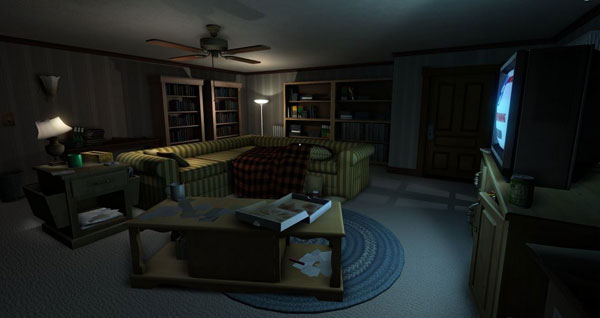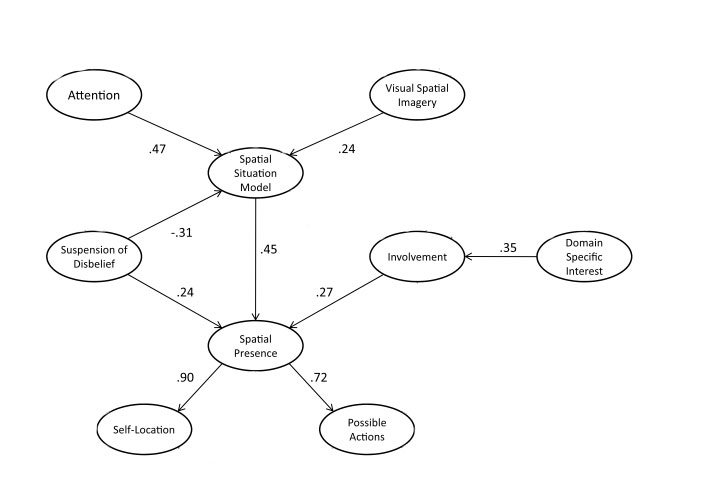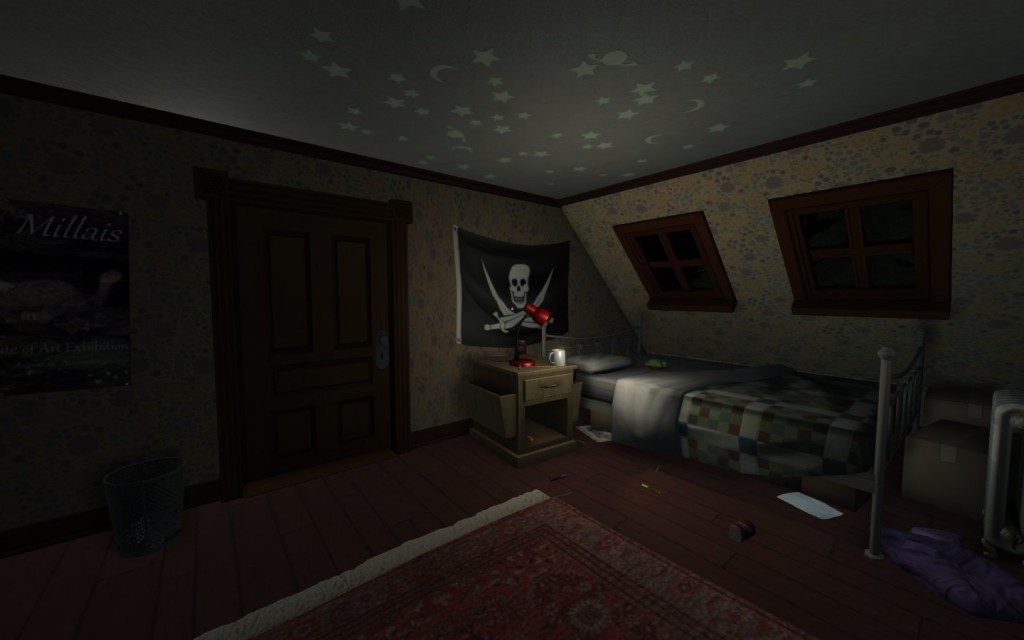Gone Home, a first person exploration game from indie developer The Fullbright Company, is getting a lot of attention lately. Much of the buzz is centered around how wrapped up in the game1 players tend to get and how immersed in its world they become. Gone Home plops you into the role of a young woman returning from a long trip to find that her family’s new house is empty. There’s just a cryptic note from her younger sister that kicks off your investigation into what the hell happened.
(Note: There will be only the mildest of spoilers for the game below –things you’d get from reading a back of the box description if this game had a box. Feel free to read on if you haven’t played it, or go and play it then come back. I’m not waiting for you, though. I’m still typing!)

Gone Home’s game world is relatively small, but incredibly dense and rich.
What’s amazing about Gone Home is that it is a textbook example of how to make a game immersive. That is, you quickly lose track of the technology between you and the virtual house that you’re exploring, to the point where you start to feel like you’re really in that game world and consider your in-game actions accordingly. I’ve written about immersion (a.k.a., “spatial presence”) in video games at length before, but the short version of how spatial presence happens is that it takes two steps:2
- Players form a mental representation of the space with which the game is presenting them –the richer and more detailed, the better.
- Players begin to lose focus on the media and technology between them and the game, and thus favor the game world as their primary point of reference for where they are.3
But not all games are equally immersive, obviously. Previous research has identified characteristics of the media, the person, and the technology that are critical to either of the steps above. Gone Home provides great examples of several of these.
First, Gone Home does so much to create a rich mental model of a familiar environment. Being able to interact with objects and having those objects consistently behave in a way that you would expect helps weave a convincing game world. One of the game’s hooks is that it happens within a small environment but that environment is extremely detailed. You can pick up and inspect almost everything –highlighters, magazines, ticket stubs, knickknacks, various reminders that your parents still have sex, WHATEVER. What’s more, you can rotate the item and inspect it up close. The game artists even carefully replicated different people’s handwriting where appropriate. And it’s not like there are a bunch of identical objects copy/pasted into the world, like there are in other open world games where you see five copies of the same book in one room. Most of Gone Home’s in-game flotsam is unique.

Gone Home requires you to stay involved by piecing the story together from bits you find around the house.
If you thought games like Skyrim were super interactive because you could pick up pots and cheese wheels, you haven’t seen anything. Gone Home has the most interactive, detailed, and believable game environments I’ve seen, and it’s clear that the developers spent a considerable chunk of their limited resources on these little details for no other reason than immersion. And while the game doesn’t fully escape the “disembodied voice reads you journal snippets” trope a la Bioshock, 4 the bulk of narrative information is presented through realistically written notes, letters, and other handwritten detritus.
So Gone Home checks off nearly every item on the “How to create a rich mental model of a virtual environment” checklist. But it has two other qualities that speak directly to that second step in the immersion process where you lose track of the real world and adopting the house at 1 Arbor Hill, Boon County Oregon as the primary reference point for where you are.
In a recent article5 Matthias Hofer, Werner Wirth and their colleagues put this model of spatial presence formation to the test using a setup that strikes some resemblance to Gone Home. Research subjects were sedated, tagged, and put in front of a computer loaded with a program known as “The House of Learning.” Within the program’s virtual environment was a two story manor with ten rooms full of displays about the life of Wolfgang Amadeus Mozart. I like to think that subjects were constantly expecting the the famous composer’s ghost to leap out and scare them.6 Regardless, study participants wandered through the house and investigated different rooms. Part of the study was to examine the importance of two related factors in creating spatial presence: domain specific interest and involvement.
Domain specific interest is a measure of how much the themes, settings, or other content of a game float your boat. If you’re way into spaghetti westerns, for example, you will have a high level of domain specific interest in Red Dead Redemption. Gone Home will probably float a lot of boats in the harbors of its target audience, since it deals with themes we can all relate to and have experience with: young love, teenage rebellion, making friends, and realizing how bad your taste in music used to be. What’s more, the game is set during 1995, and anyone who spent formative teenage years around that time will delight in many references to its pop culture. Video tapes, music tapes, concert posters, toys, SNES games, and other icons of the era are everywhere to be found in the house.
Hoffer, Wirth, and their co-authors argue –and found in the course of their study– that this kind of domain-specific interest motivates media users to focus more of their precious attention on the game and interact with it more deeply. Which in turn results in the next reason why Gone Home is so immersive: Involvement.
Involvement, the researchers say, is intense, prolonged focus of attention and thought on the media. It’s thinking hard about the game’s virtual environment and wondering how it relates to you and what you’re doing. But it’s not simply paying attention to something. Rather, it’s effortful and deliberate mental processing of the virtual world.
Gone Home is very easy to become involved with. In fact, it demands involvement, because very little is spelled out for the player, who has to piece together scraps of the game’s narrative through information gleaned from all those intricately modeled objects, notes, and other clues. You have to search for sources of information, figure out from whose perspective that information originated, how it fits in chronologically, how reliable it is, and many other factors. The clues are often vague, so much of the game’s enjoyment comes from letting them tumble around in your mind and constructing a narrative that makes sense. Plus the writing in the game is so good that you WANT to find out more about what’s going on, which requires ever more involvement, which according to the research cited above leads to more spatial presence (i.e., immersion).
For all these reasons, Gone Home is a textbook example of many of the ways to create immersion, and I honestly think that media researchers studying spatial presence should be using it in their research. It’s much more likely to create spatial presence than a house full of Mozart infographics. There are other aspects of the game that facilitate a rich mental model and adoption of that model as a reference point for location, but its incredibly interactive and detailed environment, broad domain specific interest, and demands for involvement are enough to do the trick.





Good read! I need to pick up this game at some point.
The power of a good mystery does seem to be a compelling factor for player involvement and immersion. Other examples might be games like Planescape: Torment where both character and player wake up in a morgue with no idea what happened to them, or Analogue: A Hate Story where the initial goal is to discover what happened on the spaceship you encountered.
A consistent and captivating setting is, as you say, another. Though it’s much easier to describe than pull off.
Just played this game and sadly I could’t get immersed in it.
To imerse yourself in this game (or arguably any game) you must be able to identify with the main character, which I couldn’t. Firstly I’m male and I’m not an US citizen nor do I live there, so I could’t make believe that I’m a young female US citizen who likes to travel.
This is maybe an over simplification, but still it holds true because the main character is an empty vessell with no real traits. You could forget this but the game keeps reminding you through different means (not gonna spoil them)
I’ve played Heavenly Sword and Tomb Raider and had better immersion in those games (I found the traits of those characters as something you could aspire to).
The only reason I played it and finished it was because of this article which helped me better understand why i did like the games that i did. For that I thank you.
Also excuse my grammar and punctuation for as i said English is not my first language (but I’m learning).
Pingback: Reseña de Videojuego: Going Home – Parte 2 | Sapere aude
This article is so badly written for game developers that it gives me a headache. Were you at any point going to elaborate on HOW these games ILLUSTRATE the psychological concepts you’re describing here?
What was the Domain Specific Interest was in The House of Learning that kept experimental subjects so hooked? Were people pre-selected for the experiment who already had expressed an interest in the life and times of Wolfgang Amadeus Mozart? Was there a control group who admitted to no such interest?
What’s the Domain Specific Interest in Gone Home? Being in a house? Knowing who your family members are? I would argue that the setting of Gone Home is so mundane, it HAS no Domain Specific Interest, it’s like the less weird areas of Second Life. Unless the Domain Specific Interest is “wondering what characters are feeling when they wrote something?” But you don’t say that. You don’t go into it at all, and so a reader is left wondering.
These are important facts that we NEED in order to see the big picture!
What is a reader supposed to learn from this article if we can’t play the games, can’t see the player metrics, and aren’t ourselves personally the players who had all these feels in the first place? We need facts about the games and data about the players to arrive at anything resembling the broad, sweeping conclusions you present, which themselves are a small fraction of what the title of the article promises. (“Why is Game X So Immersive?”)
You did a good job showing us Psych 101 vocabulary terms, and your transitional phrases are so varied that I almost didn’t notice that you’re grouping information in paragraphs at a high school level. But we need you to step up your game, here, now that you’re writing for a real big people website. Give. Your. Audience. All. The. Information. You. Used. To. Reach. Your. Conclusions.
I’m looking at screenshots and I see a competently lit house scene made in the Unity engine. It’s nice and moody, but not appreciably more so than any other game out there. It honestly doesn’t seem all that immersive based on graphics alone. You explain how, by not having multiple copies of the same object, they avoid some of the Uncanny Valley Effect we actively employ our Sense of Disbelief to ignore in games like Fallout 3 and Skyrim. (I would suggest, based on the definitions presented in this article and having NO prior psychological training, that probably Domain Specific Interest shoulders the burden of keeping the player invested in these games, followed by Gameplay.)
Your explanation of Involvement here is extremely fuzzy, actually. I had a difficult time figuring out whether or not it maps to “gameplay” or “interaction” or any other terms we would be familiar with as gamers.
I suppose game verbs would go under Possible Actions, but the world’s response to those game verbs *MIGHT* be Involvement? But it seems like you’re saying that in the specific case of Gone Home, Involvement comes not from having the world actually react to your investigations, but rather by imagining how the characters who wrote the notes are reacting to each other. Your own mental map of the relationships between characters updates every time you read a new note. I would probably label that that “Domain Specific Interest: Gossip,” but I can see how it breathes life into the characters and the setting by establishing both interpersonal relationships and the passage of time, something that even the most expensive AAA games usually have a huge blind spot when it comes to modeling.
I am VERY interested in getting a better explanation of “Involvement” out of you. Like, the dictionary definitions you give keep coming back to “the player is INVOLVED! You know, like, involvement!” And that’s not helpful. I have no idea if Involvement meant to be personal and subjective or not.
Like… give me an example of one game with Low Involvement and another game with High Involvement, explain to me what made it High or Low Involvement for you, establish to what extent other players might reasonably be expected to have contrary Involvement levels to the ones you reported, and then distinguish between Domain Specific Interest and Involvement one more time just for good measure, so I can be sure I understand why a sentence like “Alice found Gone Home very Involving while Bob did not” indicates Involvement and not Domain Specific Interest.
Actually now that I think about it, it seems Domain Specific Interest feeds directly into Involvement in the Hoffer diagram, so I suppose Domain Specific Interest is the personal mental groundwork necessary to understand cause and effect within an environment, while Involvement is the personal act of processing the environment using that Domain Specific Interest? Is any of this even close to right? I would look these terms up on Wikipedia, but I am not interested in being Right, here. I want you to understand that your article is vague and confusing, that this is the mental place your article has driven me to, that I needed to forge these connections and deductions on my own using context clues, and that as a result I have no faith in the soundness of my understanding of the information you presented in your article.
In an academic environment, you could chalk this lack of understanding up to a dull student, and tell me to go ask for help in the Psychology Lab or whatever, but this is all happening on a website about video games. I read video game articles all the time, and they are usually easier to understand than this. And it’s not because I don’t understand the psychology terms. Rather, it’s because psychology terms appear to be pretty much the only thing you defined, here, before presenting your conclusions.
Pingback: Research Articles | Jim Scull's Game Design
Pingback: Game Design | Annotary
Pingback: 为何《到家》具有如此强大的沉浸感? - 爪游控
Pingback: Would the Holodeck be any fun? 4. Process Intensity: Game as Referee | Concept Sandbox
Pingback: Would the Holodeck be any fun? 6. How to Make Games of Worlds | Concept Sandbox
Pingback: What you see is not always what you get: The Use of Horror Tropes and Themes in Gone Home – Videogames and/as Literature 2017
Pingback: 7 ways games use psychology to control you – Psychology Roots